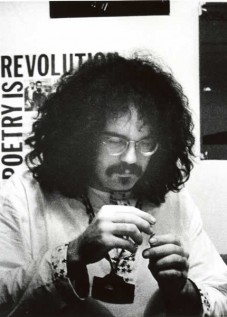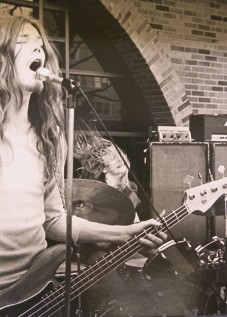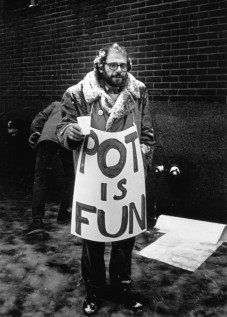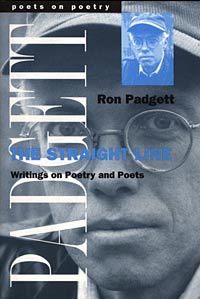MC5: The Most Radical Band on the Planet
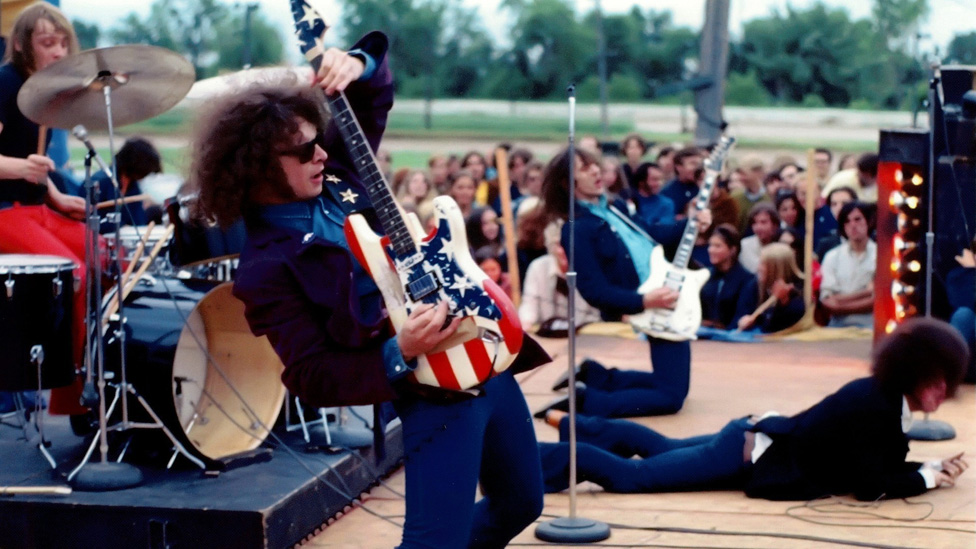
MC5, Ann Arbor 1969 – Photo © Leni Sinclair
MC5: The Most Radical Band on the Planet
by Cary Loren
“When the mode of the music changes, the walls of the city shake.” –Plato
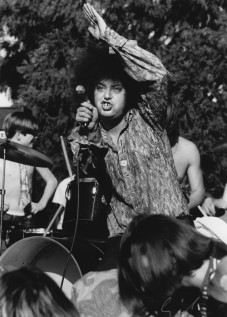
Rob Tyner at Provo Park in Berkeley on Sunday March 23, 1969, photo by Emil Bacilla
TRANS-LOVE+ENERGIES= MC5 / GRANDE BALLROOM
The early Artists Workshop was focused around jazz music, art, film, photography, and poetry. The year 1966 brought a radical change. A psychedelic world opened the floodgates and transformed the times. Rob Tyner and Gary Grimshaw were early advocates of the Artists Workshop –back in 1965 hanging out at Sunday afternoon Jazz shows as a young teenagers. When John Sinclair came out of prison on his second marijuana conviction, a psychedelic planet had been born.
The “Festival of People” took place on Aug. 7, 1966, a day-long affair celebrating the release of Sinclair and the revival of the Artists’ Workshop . The MC5 played at the “Festival of People” beginning late at night, perhaps 1 am. John and Leni retired after the third song. “…and then Leni Sinclair came downstairs and pulled the plug. “Never happened to us before,” said Rob Tyner. “We were never censored like that. Here we were, being censored by a bunch of beatniks. It was weird, we were knocking ourselves out to please.” ( Rob Tyner quoted in The Legends of the MC5)
It took one meeting with Rob Tyner and Frank Bach to convince Sinclair that the MC5 was offering something new, radical, and powerful. A musical vision as close to Free Jazz as rock could get. Tyner’s vision was to create a hybrid of the free-jazz movement married to psychedelic rock, just as Sinclair’s vision was to cross rock ‘n roll with radical politics.
They were trying to extend rock and roll into something that had more space for creativity and improvisation. They called themselves avant-rock at the time…They were people that were totally into their music and into trying to make their music more effective and their whole performance aesthetic more complete.… they fused with jazz instead of fusing jazz into rock. So there’s all these different aspects of them that have come down in history…They built a mass following in their hometown. In Detroit, the MC5 was as big as the Rolling Stones. We headlined all the local (bands) show at Olympia Stadium and drew more people than the Beatles… — excerpt from John Sinclair interview on MC5 on Furious.com Perfect Sound Forever
Trans-Love Energies emerged when Sinclair shared a peace offering joint between Tyner and Bach as they listened to Cecil Taylor. A year later, Trans-Love became a nontraditional business conglomerate of various bands, light shows, artists, underground newspapers, posters and head-shops. Sinclair saw the growing potential for rock as a vehicle for radical change and action. As full-time manager of the MC5, “the most radical band on the planet,” and with the antiwar movement in full swing, John recognized this prime opportunity to “indoctrinate” “turn-on” and freakize American youth, to expand Trans-Love into a cultural weatherstorm. Fusing radical politics, outsider culture, poetry, free-jazz, sex and dope (marijuana) with rock and roll with a socialist-communal base became Sinclair’s program. His efforts went toward educating and radicalizing. There was massive work to do. Tyner, Sinclair, and Grimshaw saw the MC5 as the perfect vehicle to command attention, as the created a weapon of cultural and political free expression.
The music of the MC5 is the city / The city is meat and energy in motion / And sound / And the sound is the MC5
–John Sinclair, WORK/5
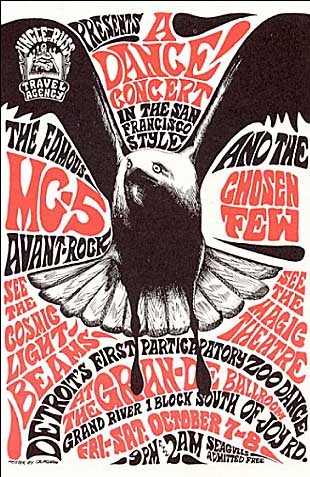
The MC5 “Seagull” poster by Gary Grimshaw. The first poster for the Grande Ballroom, Oct., 1966
The opening of the Grande Ballroom (October 7th, 1966) kicked the Detroit psychedelic movement into high gear. In the summer of ’66 rock entrepreneur, school teacher and WKNR-FM radio personality “Uncle” Russ Gibb [Uncle Greed to some] saw the possibilities of the exploding hippie movement during a visit to Bill Graham’s newly opened San Fransisco, Fillmore Ballroom. He then commissioned one of the largest strobe lights ever built, and installed it in the Grande Ballroom on Joy and Grand Boulevard in Detroit. The Grande was a 1920s dancehall, designed in faux-Arabic Moorish style revival; with an oriental wooden dance floor set on springs; it oozed baroque plaster ornamentation, intricate mosaic tiles and large arched doorways. It quickly made the conversion into Detroit’s first rock palace. Sinclair saw a partnership in the offing and installed the MC5 at the Grande as the “peoples” band.
“The first day 50 people showed up,” said Gibb. “The next week it was 100, then 500 and then 1000.” Every weekend the scene exploded at the Grande and waves of local bands appeared. Grimshaw’s poster art celebrated the scene and branded the MC5 into a cultural artifact. Grimshaw art flourished under the direction of a psychedelic inspired culture. Groups like the Rationals, Savage Grace, The Frost, The Scott Richards Case, the Psychedelic Stooges, and the Früt all found a home on the Grande’s stage and in Grimshaw’s poster art. Word spread to the white suburbs and overflowing crowds stormed the ballroom every weekend; crazed kids on LSD and marijuana searching a way out of the mowed lawns and wire fences.
The Grande attracted international rock bands like The Who, Cream, and Janis Joplin with Big Brother. The Grande became a rite of passage for touring bands. A Detroit audience was the litmus test. They made a loud howling foot-stomping noise, showing their rowdy love for the music. The MC5 played almost every weekend, earning $125 a week, a figure that never changed even as they were packing the ballroom, opening for international acts, and often blowing them off stage. Gibb supplied the space and bookings and Trans-Love created the scene; the light-shows, roach clips, flyers, posters, and underground papers. A pipeline of LSD came into the city through Grimshaw’s connections with the Family Dog in San Francisco.
PLUM STREET (Detroit’s bid for a flower-power neighborhood) and the Grande offered youth an exotic destination, an escape into urban-life and rock music untamed. “A dance in the San Francisco style” stated the ads. During the 1967 Detroit riots, Uncle Russ wondered why the Grande was spared, when other buildings around it were torched. A group of neighborhood kids said, well because man, that’s where the music is happening.
UNIVERSAL WISDOM
“Let me put it as simply as I can: I was probably even more deeply influenced by Tyner’s thought and practice than he was by my own, and –with the possible exception of Thompson–so was the rest of the band.” –John Sinclair, Reprise in The MetroTimes
Like all other bands, the MC5 evolved out of a garage rock aesthetic, but adding their embrace of avant-jazz and roots music, the MC5 became something more, they were music ambassadors; a bridge to black culture. Both Sinclair and Tyner came off the same page, passing on their love energy of John Coltrane, Albert Ayler, Cecil Taylor and Sun Ra through the MC5 into the public. Rob Derminer changed his name to Tyner after his jazz hero: pianist McCoy Tyner. This avant-garde vision was in his game plan at the beginning. Tyner spent his teen years hitting jazz clubs and sneaking into the Artist Workshop Sunday events to hear live poetry and jazz. Tyner was a dedicated driven force–committed to social justice and change.
Sun Ra, Ayler and Coltrane represented the higher stratosphere of ideas. Sinclair initiated contact with Sun Ra in 1965, when he traveled to New York City to conduct an interview for an early issue of the Warren/Forest Sun newspaper. Sun Ra and his Solar Myth Arkestra represented a parallel mind-set to the Artists’ Workshop; they practiced do-it-yourself aesthetics; ignored mainstream distribution and held disciplined work ethics. Sun Ra’s Arkestra also lived and worked communally since the early 1960s; first in Chicago, New York and then settling in Philadelphia.
On their first album, the MC5 gave tribute to Sun Ra by including his poetry on their song “Starship;”
There is a land Where the sun shines eternally, Eternally eternal: Out in outer space a living blazing fire…
Sinclair hosted several concerts by Sun Ra and the band often camped out at the Hill Street house in Ann Arbor. This influence of jazz on the MC5 is well documented. What is interesting is how they took that passion; that spiritual quality of jazz, putting it over into rock ‘n roll. Fred “Sonic” Smith constructed his own theory about music and its wave construction. When playing solos Smith visualized sin-waves on a spectrometer; watching waves as images cresting up and down on a graph. Smith saw the universe constructed as sound and he visualized these waves during each performance.
There is a land
Whose being is almost unimaginable to the
Human mind.
On a clear day,
We stand there and look farther than the
ordinary eye can see.
Far above the roof of the world,
We can encompass vistas of the worlds.
There is a land
Where the sun shines eternally . . .
Eternally eternal:
Out in outer space
A living blazing fire,
So vital and alive . . .
There is no need to describe its splendor.
–Sun Ra
HIGH TIME : A LAUNCHING PAD
The Ramones were indebted to the intense style and high powered antics of Detroit bands like the MC5, Up and Stooges. They often cited Back in the USA as a blueprint and seminal influence. The patched up and torn uniforms of Patti Smith, the Ramones and Dead Boys were worn everyday by Iggy years earlier; a rag street style that said screwoff to store bought goods. Sigrid Dobart and Becky Tyner helped the MC5 develop a strange array of over-the-top freaky costumes; using glitter, spangles, tight sewn-on jeans and torn American flags; twisted American folk-art wear. Dobart and Tyner found their materials in second hand stores and close-out bins. Years before glitter rock surfaced, the MC5 and Alice Cooper were blending rock into raw androgynous theater with glam space costumes and choreographed stage moves.
The MC5 went into orbit when Sigrid Dobart put together a superhero space suit for her husband, guitarist Fred Smith –a silver space-suit years ahead of the glitter-rock of the ’70s. Smith debuted his space helmut and cape at the Michigan State Fairgrounds and was seen on the cover of High Time.
“I was disgusted with ’em… I didn’t understand it. It was kind of a menacing thing. They’d gone outside the format… Fred Smith in a spaceman outfit?!? I thought they’d lost their fuckin’ minds! … it was inauthentic!”
-John Sinclair
The ’70s punk scene in both Europe (British punk) and America can be seen as inspired and fueled by a handful of high-octane albums from the motor city. The influence of Detroit rock was profound in late 1980s New York and Seattle noise bands also known as shoe-gazers, for their pose of often staring at the ground. By using noise and “controlled feedback”, the MC5 took rock to its outside limits. Early performances by the Stooges were experimental happenings that had nothing to do with rock… Iggy was a student of performance art. The MC5 performed a live soundtrack for the Living Theater’s Paradise Now, taking it to the edge of pure noise. This even was too extreme for their manager Sinclair, who was now weary and disgusted by where the band was going.
BLACK TO COMM : RE-ENTRY
The MC5 ended each set with a free-form sonic weirdness called Black to Comm— a Fred Smith riff and Rob Tyner freekout, balls-to-the-wall Avant-skronk rock number that ended with JC Crawford, Fred Smith and John Sinclair wailing with saxophone honks, and the audience stripping down, dancing wildly on stage, flags burning, shredding guitar riffs, feed-back swirling.
Tyner named the song after the wired connections on the back of the PA system–and invented the art of making a solo on the microphone; messing with the piercing feedback as he’d point the mic into the speaker cabinets. Wayne Kramer said, “We could clear the room in 30 seconds when we played Black to Comm… and that’s when we realized we were onto something.”
I felt it in my group, you know, like “unhhh, unnhhh, I’m cooking,” and POW! – one night we EXPLODED. We didn’t care if the people dug it or not, and musically we just exploded. We used to do our “avant” numbers as sort of unleashing a monster on the crowd – we didn’t even care if they liked it, we hoped they hated it, because we were killing them, we were shooting them down with these monstrous amplifiers and we just didn’t care. We were obnoxious. We’d get up and do all of our tunes, and then at the end, we’d COME. –Rob Tyner (from a Sun interview with John Sinclair)
Patti Smith was introduced to Fred Smith through her guitarist Lenny Kaye in 1976; and she based her LP Radio Ethiopia on Black to Comm. Bands influenced by the MC5 are too numerous to list, but one solid upfront quotation came from experimental rockers Sonic Youth–best known for their oddly tuned droning feedback and high-energy noise squall. They adopted their name from Fred “Sonic” Smith as an homage . SY went on to influence countless other shoe-gazer bands, including noise-rock supergroup Nirvana. In his published diaries, Cobain cited his top favorite albums of all time as; Raw Power and Kick Out the Jams.”Rock & roll magazines were really important to me,” said Moore. “CREEM came out of Detroit so you would see a lot of images of the MC5 and The Stooges. I couldn’t hear what it sounded like, but it looked great. So I would go to record stores and ask them to order these albums because they didn’t have them. They would get one copy and I would go buy it, like The Stooges’ Fun House.” (Thiurston Moore wrote in Thurston Moore’s Musical Education.)
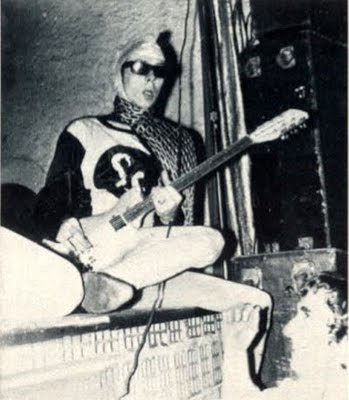
Fred “Sonic” Smith in his Space suit.
Avant-Rock was liberation; a fusion of protean noise and protest; the noise of adolescence breaking out and apart, an extreme edge of sonic improv. Rock and roll in a garage or basement is a rite of passage. Guitars, drums and amplifiers are instruments easily found and not difficult to play. After the breakup of the Stooges and MC5 in the early ’70s –other reactive groups carried on in the same tradition of avant-rock and industrial noise; Throbbing Gristle, Destroy All Monsters, and the LAFMS all used noise strategies carried to the outside-territories –making their own instruments, using blenders, toys, drills and electric shavers; borrowing from free jazz, street musicians, electronica art and outsiders. In the late ’80s another off-shoot of avant-rock happened in Japan with bands like the Boredoms, Keiji Heino, Merzbow and others–using computers, condenser microphones placed in the mouth,psychedelic feedback and electronic waste. Japanese noise was broiught the the states and noise bands sprouted again in the midwest. Aggression in music never dies. It gets reborn again as something more ugly, radical and incomprehensible.
The techno movement was a reaction away from rock and high-energy; it provided a mask of toned down coolness, electronic pools of bliss. Techno had a satisfying sense of “control” and regularity and easy to control technology verses Rock’s barbaric chaos and freedom. Minimalism vs. Maximalism. The driving beats of techno are mostly virtual ones; juiced up computer algorithms, composed in the darkroom. New Age music repackaged as dance grooves for a new hip consumerism.
The beauty of the techno underground is the invisibility of the barrier between man and machine; it produces predictability. An outcome that is trancelike for the body and mind. There’s no longer the need to study the form or hold an instrument in the hand. Fingers are now for pushing buttons and to enter the matrix. In techno, the rawness, identity, and humanity of the voice is neutered, desexualized, cut off, and unnecessary. Improvisation means changing the beat or melody in subtle ways. The unity of the group or band community dissolves into a single consciousness; a focused and packaged musical fascism.
When voices are used in techno or electronic music (and they rarely are) they are often “treated” –a mechanical tool; non-emotional, robotic and flattened, made ambient with over-layering, compression or phased effects. Kraftwerk pioneered these effects. New music is the domain of elite sound architects; the wizards who create software and sell their inventions on laptops and cell phone. Music as a cheap byproduct of electronic software, where human energy has been modified and sold.
“… Tyner was himself a radical firebrand and a charismatic frontman who sang fervent pleas from the stage urging people to rise against the government..and its human being lawnmower of a system..” – John Sinclair
The MC5 wanted to shatter chains and prisons: break down jail house doors, ending all the games with their high energy jams! Guitar cords, raw screams and Black to Comm. Where is rebellion and emotion in our current sea of blind happiness inc. and American Idol? Nothing Is. (as Sun Ra said) The Red Squads are now underground, holy invisible! Seek and download. And remember those words of wisdom spoken during 9/11, when President Bush told us all to go shop our way out of a crisis. The MC5, rest their souls –gave the rest of us a clue, where music and revolution could take us.
“People of tomorrow we salute you… Thunder in the night forever!” –Rob Tyner
[Cary Loren 2005/ revised 2014]
Tags: Cary Loren, essay, MC5, Rob Tyner, Rock 'n roll



